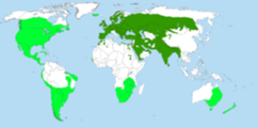House Sparrow
Scientific name
The house sparrow is scientifically known as Passer domesticus.
Family
It belongs to the family Passeridae, which includes several species of sparrows.
Location
House sparrows are found in many parts of the world, including Europe, Asia, Africa and North America. They are adapted to living in urban and rural environments.
Behaviour
House sparrows are social birds that tend to live in groups. They are known for their fast and agitated flight. They spend a lot of time on the ground searching for food and can be seen in urban areas and parks.
Feeding Habits
House sparrows are primarily granivorous, meaning that they feed mainly on seeds. They also consume insects and other invertebrates, especially during the breeding season when they need protein to feed their young.
Reproduction
The breeding season for house sparrows can vary by region, but generally occurs in spring and summer. They build nests in cavities, such as holes in trees, eaves of buildings and nest boxes. Females lay 2-5 eggs, which they incubate for about two weeks. Both parents participate in feeding the chicks until they are independent enough to fly and forage on their own.



